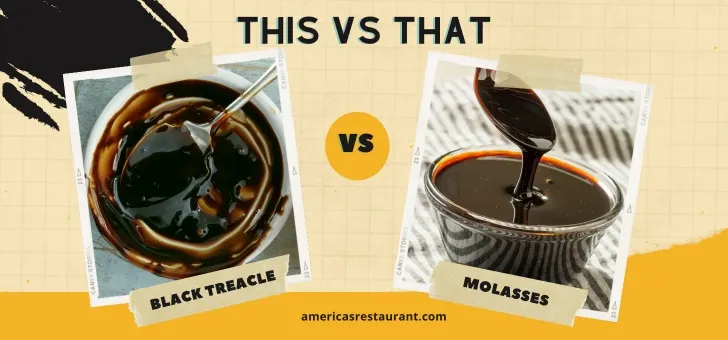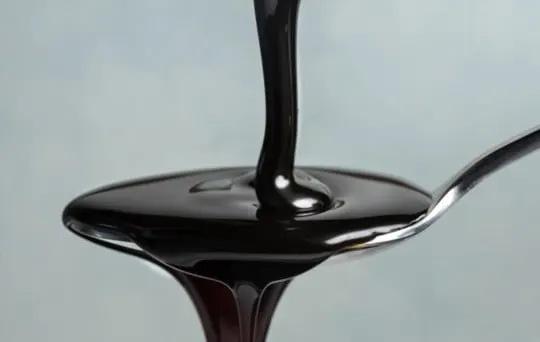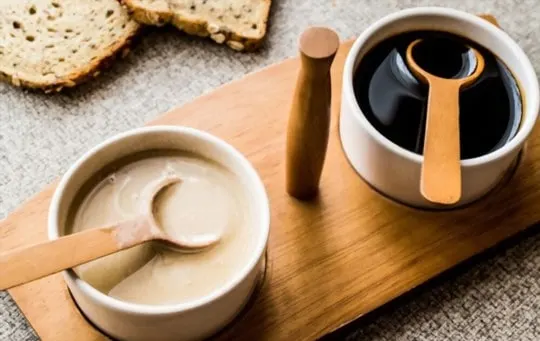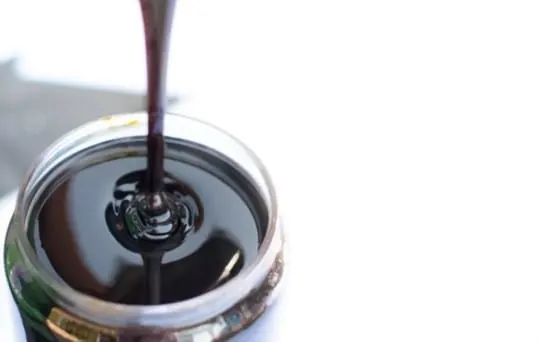In the sweet corner, we’ve got black treacle. Its dark, intense flavor sets it apart.
Molasses, on the other side, isn’t just a one-trick pony with its rich history in cooking.
We’ve all been there, standing in the baking aisle, scratching our heads.
Should we reach for the treacle or molasses?
Our kitchens have seen battles. The cookies that could. The gingerbreads that almost weren’t.
Through it all, we’ve learned a thing or two.
And here we are, ready to spill. Not literally, though. That’d be messy.
Get ready for a showdown that’s been brewing in pantries everywhere.

What is Black Treacle?

Black treacle, also known as molasses, is a dark and sticky syrup extracted from sugarcane during sugar production.
In its viscous form, black treacle can be used in cooking or baking as an alternative sweetener or condiment.
It is high in minerals like iron, calcium and magnesium which are essential for good health.
When compared to its lighter counterparts, black treacle has a richer and deeper taste as it contains more molasses.
This allows it to add a distinctive flavor to dishes like gingerbread cookies or dark chocolate cakes.
However, due to its strong taste, it may not be suitable for all recipes.
It is worth noting that while black treacle shares similarities with regular molasses, they are not the same product.
Black treacle has been cooked down further and contains additional sugars that give it a unique flavor profile.
When deciding between the two options, consider the specific needs of the recipe and personal taste preferences.
What is Molasses?

Molasses is a byproduct of sugar production, obtained from the boiled juice of sugar cane or sugar beets.
It has a dark brown color, thick syrupy texture and rich flavour that varies depending on the type of molasses.
Molasses is often used as a sweetener in food and beverages, as well as in industrial processes like fermentation and distillation.
Its distinct taste profile makes it a popular ingredient in baking recipes such as gingerbread, cookies, muffins, and cakes.
Due to its high nutrient content and natural sweetness, molasses is also considered healthier than refined sugars.
Differences Between Black Treacle and Molasses

Black Treacle and Molasses are both dark, viscous syrups with a slightly bitter taste.
The primary difference between the two lies in their production process.
Black Treacle is the residue left after refining sugarcane juice while Molasses is a by-product of the sugar-making process.
Black Treacle has a higher sugar content than Molasses, making it sweeter with a caramel-like flavor, while Molasses has a distinctive robust flavor ideal for use in baking and cooking.
Black Treacle is less viscous than Molasses, making it an excellent choice for glazes or sauces.
It’s essential to note that the nutritional value of both these syrups is similar, with trace amounts of vitamins and minerals.
So, choosing between these two depends entirely on your taste preference and intended use.
Origin and Production
Black Treacle and Molasses are two common ingredients in the food industry that have distinct differences.
Both are by-products of sugar production, but Black Treacle is made from cane sugar while Molasses is derived from beet sugar.
Black treacle is produced by boiling the residual syrup leftover from raw cane sugar processing.
It has a thicker consistency, darker color, and stronger flavor than molasses.
The process for producing black treacle involves the removal of all sugar crystals plus partial or complete invert sugar formation.
Molasses production begins with beets that contain sugars that are extracted and refined similar to cane juice processing.
However, what differentiates molasses from other products is its high level of impurities compared to refined white sugar.
These impurities contribute to its distinctive texture and taste.
Ingredients and Flavor Profile
Both are viscous syrups rich in antioxidants, vitamins, and minerals.
Black treacle is made from the residual syrup after sugar is extracted from sugarcane juice.
It has a bitter-sweet flavor with nutty undertones due to a high concentration of molasses.
On the other hand, Molasses is obtained by boiling sugarcane or sugar beet juice until it thickens and crystallizes.
It has a deep, rich aroma with a distinctive bittersweet flavor profile owing to its blend of glucose and fructose.
While both these syrups have similar health benefits, Black treacle has higher amounts of vitamins B6, magnesium, iron and calcium present in it than molasses.
Black treacle’s strong flavors pair well with savory dishes making it popular as a marinade for beef dishes, homemade BBQ sauces, gingerbread cakes etc.
On the other hand molasses’ mellow sweet flavor works great in baked goods, smoothies as well as glazes for ham or pork chops.
Texture and Consistency
Black treacle and molasses are both sugary syrups with a dark hue, but their texture and consistency differ.
Black treacle is thicker, stickier, and more viscous than molasses.
The high viscosity contributes to its thick texture that clings to surfaces.
In contrast, molasses is thinner and less dense compared to black treacle.
When it comes to cooking or baking, these differences can affect the outcome of recipes.
For instance, since black treacle is heavier, it won’t flow as smoothly as molasses.
Recipes calling for black treacle may require dilution with water for smoother pouring while maintaining the flavor profile.
Furthermore, the density of these two syrups affects their nutritional content.
Since black treacle has a higher density than molasses, it contains more calories per tablespoon.
However, molasses contains more vitamins and minerals like iron due to its lower sugar concentration.
If you’re looking for a syrup that adds depth in flavor to your dishes or baked goods- both options offer unique flavors profiles requiring different textures depending on the recipe needed.
Usage in Culinary Applications
Black treacle and molasses are versatile ingredients in culinary applications.
Chefs worldwide use the two dark, thick syrups for their unique flavor and nutritional benefits.
These sweeteners are common in cakes, cookies, marinades, glazes, and barbecue sauces.
Molasses is a byproduct of sugar refining with a robust flavor profile ranging from light to dark shades.
Its nutty and bittersweet taste makes it an excellent accompaniment to gingerbread cookies or holiday pies.
Black treacle’s syrupy, caramel-like consistency complements savory dishes such as beans or meatballs.
Furthermore, molasses is rich in minerals such as iron, calcium, potassium, and magnesium, while black treacle contains vitamins B3 and B6.
Both sweeteners are used interchangeably in some recipes; however, they differ in taste intensity.
Incorporating black treacle or molasses into your recipe can add depth and complexity to its flavor profile.
Their usage may depend on personal preference or regional availability.
In summary, black treacle and molasses are crucial ingredients that give a unique spin to savory or sweet dishes.
Understanding the differences between these syrups is vital for achieving optimal taste results in your culinary creations.
Nutritional Comparison of Black Treacle and Molasses
Black treacle and molasses are two popular sweeteners that have been used for centuries.
A comparison of their nutritional value can help choose between them.
Black treacle is a byproduct of sugar refining, and molasses is the residual syrup obtained during sugar production.
Both black treacle and molasses are highly nutritious and provide a range of vitamins and minerals like calcium, iron, manganese, potassium, copper, and magnesium.
They also contain antioxidants that may reduce oxidative stress in the body.
When it comes to calories and carbohydrates, black treacle has slightly fewer calories than molasses but more carbohydrates.
Black treacle has a glycemic index of 98 which means it can raise blood sugar levels quickly.
In comparison, molasses has a lower glycemic index (55) which makes it a better option for people with diabetes or seeking to control their blood sugar levels.
However, both sweeteners should be consumed in moderation as too much consumption can lead to weight gain due to high calorie content.
Similarities Between Black Treacle and Molasses

Both black treacle and molasses are thick syrups produced from refined sugar.
These syrups are created through the process of boiling sugar cane juice until it becomes concentrated and syrupy in texture.
The color of these syrups is primarily dark brown, with a slightly bitter taste.
Both of these sweeteners can be used as a substitute for one another in recipes.
Therefore, we can say that there are many similarities between black treacle and molasses.
Both black treacle and molasses contain significant amounts of iron, calcium, potassium, and magnesium.
These minerals provide numerous health benefits to the human body.
Additionally, both substances contain high levels of natural sugars that can prove useful when preparing meat dishes due to their ability to develop caramelization on meat surfaces during cooking.
They both help to add flavor depth and complexity to dishes.
While black treacle is primarily used in baking as a sweetener for cakes and pastries, molasses is typically used in savory dishes like barbecue sauce or baked beans because of its thickness.
Furthermore, molasses has a slightly more robust flavor than black treacle due to having been boiled for more extended periods.
Therefore, although there are some slight differences between black treacle and molasses concerning their respective usage and taste profiles, the similarities between them outweigh these variations significantly.
Both of these syrups provide adequate nutritional value while improving the flavor profile of any dish they’re used in.
Considerations When Choosing Between Black Treacle and Molasses
Black treacle and molasses are two sweeteners that share some similarities but have distinct differences.
Factors like flavor, nutritional value, and intended use can influence the choice between them.
Molasses has a bittersweet taste and is darker than black treacle.
It contains more vitamins and minerals, including iron, copper, calcium, magnesium, potassium, and vitamin B6.
However, it also has a higher calorie count and sugar content than black treacle.
On the other hand, black treacle has a strong caramel flavor and is often used in baking or cooking sweet dishes like gingerbread or parkin.
It’s less nutritious than molasses but still contains some valuable minerals like potassium and magnesium.
Also, it has fewer calories than molasses.
When choosing between these two sweeteners, it’s essential to know what suits your needs best.
For instance, if you’re looking for a sugar substitute that adds flavor without adding calories or nutritionally dense sweetener for smoothies or oatmeal bowls – then molasses might not be the better option over black treacle.
Recipes and Cultural Preferences
Foods and traditions vary across cultures, which also influences the recipes people enjoy.
The use of black treacle or molasses is no different, as it comes down to preferences in certain global cuisines.
Both products come from sugar cane processing and offer unique characteristics that can enhance dishes with deep flavors and textural complexity.
Molasses, a darker variety of sugar syrup produced by boiling sugar cane juices, offers slightly bitter notes accompanied by a sharp sweetness in every drop.
This makes it an ideal secret ingredient for baked goods where natural caramelization occurs, like sticky toffee pudding or gingerbread cookies.
For example, American cuisine has incorporated molasses into recipes such as Boston baked beans or barbecue sauce due to its perceived depth of flavor.
Black treacle, on the other hand, possesses more subtle malty flavors that lend themselves better as glazes in savory dishes such as roasted meats or fish fillets.
Its viscosity allows it to serve as an effective moistening agent in bread-making processes too.
British cuisine features black treacle heavily in various desserts including the iconic Yorkshire parkin cake.
Understanding the differences between these two sweeteners is critical when cooking international dishes or creating new ones that call for unfamiliar ingredients.
The choice between using black treacle or molasses is contingent on one’s preferences rather than quality since both contain essential minerals like iron and calcium.
Health Benefits and Dietary Restrictions
Are you trying to decide between black treacle and molasses, but not sure which is the better option for your health and dietary needs? This article explores the various health benefits and restrictions associated with these two sweeteners.
- Both black treacle and molasses are natural sweeteners that contain beneficial minerals such as iron, calcium, magnesium, and potassium.
- Black treacle has a lower glycemic index than molasses, making it a better option for people with diabetes or those who need to regulate their blood sugar levels.
- Molasses is a good source of antioxidants due to its high level of polyphenols. Antioxidants can help protect against free radicals in the body that contribute to disease.
- For those following a vegan or vegetarian diet, both black treacle and molasses are safe options as they are derived from plant sources.
- People with digestive issues such as irritable bowel syndrome (IBS) may need to limit their intake of both black treacle and molasses due to their high fructose content.
- If you are watching your calorie intake, be mindful of the amount of black treacle or molasses you consume as they are high in calories.
It’s important to note that while both black treacle and molasses offer some health benefits, moderation is key.
Consult with your healthcare professional or registered dietitian if you have any concerns about incorporating these sweeteners into your diet.
Conclusion
Comparing Black Treacle and Molasses reveals that both are good substitutes for sugar.
However, they differ in taste, texture, and health benefits.
It’s important to note that both have high concentrated sugars levels when compared to regular granulated sugar.
Therefore they should be used sparingly as consuming too much can lead to health problems like diabetes or tooth decay.

Leave a comment